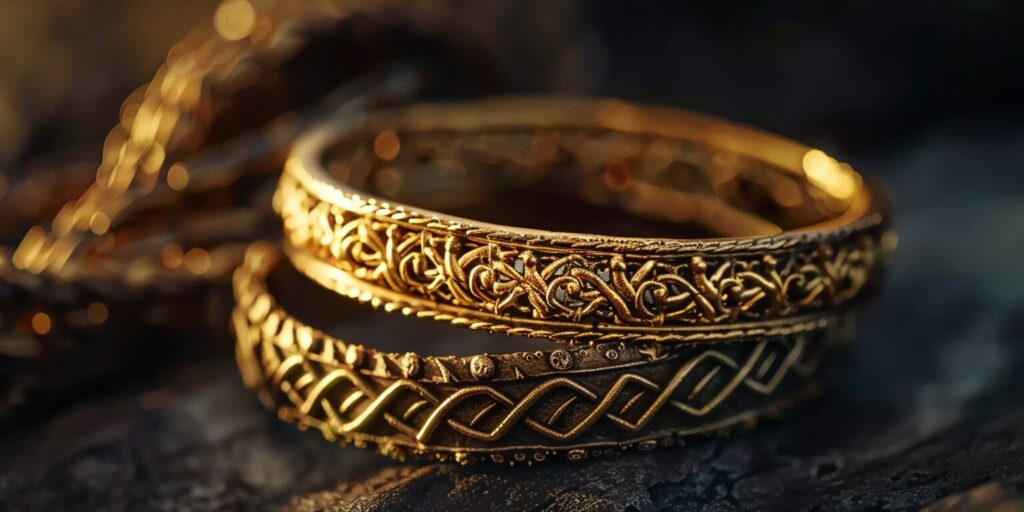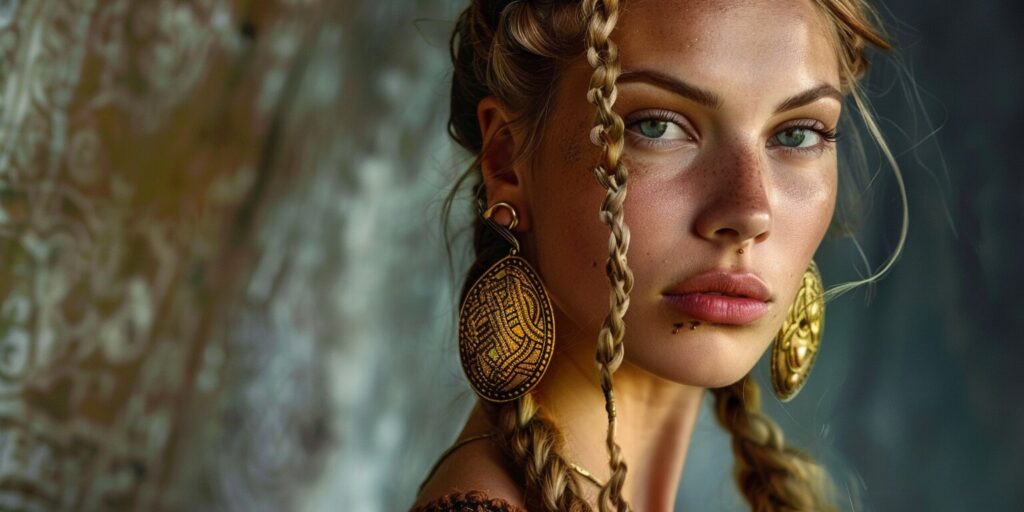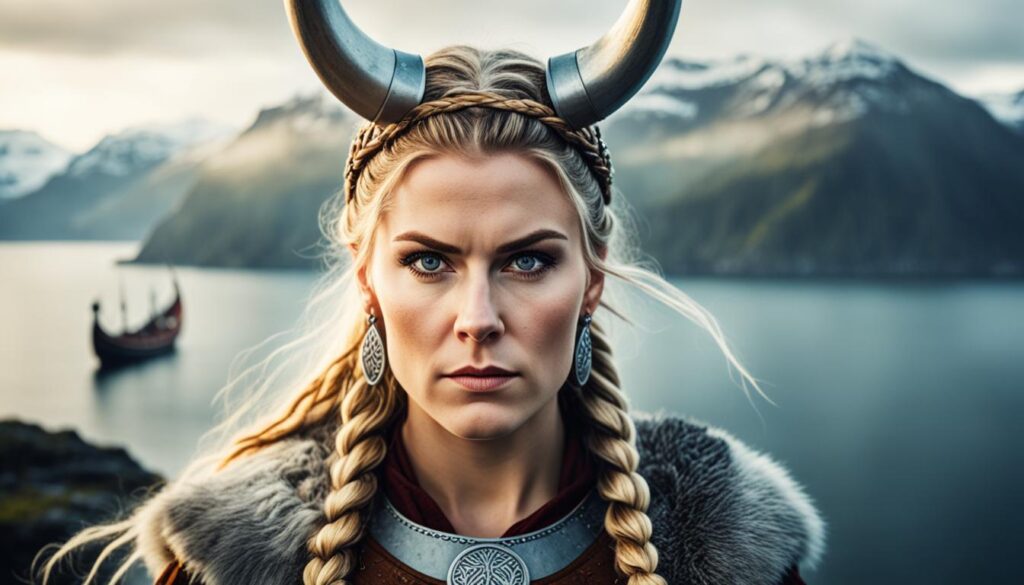Daily Life in the Viking Age, Viking Clothing and Jewelry, Vikings
Did Viking Women Pierce Their Ears?
Ear piercing has been practiced by numerous cultures throughout history, each with its own significance and symbolism. In this article, we will delve into the world of the Vikings to understand their traditions, examine archaeological findings, and consider the role of ear piercing in their society.
Viking culture, known for its seafaring ventures and warrior ethos, encompasses a vast array of traditions and customs. With a keen focus on craftsmanship and artistry, the Vikings were known to adorn themselves with intricate jewelry and accessories. This leads us to question did Vikings pierce their ears and what it may have represented to Viking women. Join us as we delve into the fascinating world of Viking culture and uncover the truth about whether Viking women pierced their ears, exploring both historical evidence and cultural interpretations along the way.
Understanding Viking Culture and Traditions
To truly comprehend the practice of ear piercing among Viking women, we must delve into the rich tapestry of Viking culture and traditions. The Vikings, also known as Norsemen, were seafaring people hailing from the Scandinavian regions during the Viking Age (793-1066 AD).
Viking culture was deeply rooted in traditions and profoundly impacted their way of life. From their exploration and trade routes to their religious beliefs and societal structure, the Vikings embodied a unique set of values and practices that continue to captivate us today.
The Significance of Viking Traditions
- Exploration and Conquest: The Vikings were renowned for their expeditions across the seas, venturing as far as North America, the Mediterranean, and the Middle East. Their bold exploration and conquests expanded their influence and enriched their cultural heritage.
- Thor and Odin: Norse mythology played a crucial role in Viking culture. Deities such as Thor, the god of thunder, and Odin, the god of war and wisdom, were revered and worshipped. Their beliefs shaped the rituals and practices of the Vikings, making religion an integral part of their daily lives.
- Warrior Culture: The world of the Vikings was steeped in martial traditions. They were skilled warriors known for their fierce fighting techniques and their iconic weapons, such as swords, shields, and axes. Warfare was not only a means of defending their territories but also a way to establish dominance and secure wealth.
- Trade and Commerce: The Vikings were esteemed merchants, engaging in extensive trade networks that spanned vast distances. Their mastery of shipbuilding and navigation allowed them to establish lucrative trade routes, fostering economic growth and cultural exchange.
- Oral Tradition: Storytelling was an essential aspect of Viking culture. Through sagas and epic poems passed down through generations, the Vikings preserved their history, legends, and ancestral heritage, ensuring the continuity of their traditions.
These cultural practices and beliefs provided a framework for every aspect of Viking society, shaping their lifestyle, art, and even personal adornment.
By exploring the Viking culture and traditions, we gain a deeper understanding of the context in which ear piercing may have existed. In the following sections, we will delve further into the practice of ear piercing in different cultures and examine the evidence surrounding Viking women’s adherence to this ancient tradition.
Ear Piercing – A Universal Practice
Ear piercing is a cultural practice prevalent in ancient civilizations worldwide. It holds significant cultural and symbolic meaning, representing various aspects of identity and status. Whether for personal adornment or religious rituals, ear piercing has stood the test of time as a universally recognized practice.
So, when did ladies start piercing their ears? Ancient civilizations, spanning from the Egyptians to the Mayans, embraced ear piercing as an integral part of their cultural traditions. In Egypt, ear piercing was regarded as a symbol of wealth and prosperity, with earrings often adorned with precious gemstones.
The Mayans, known for their advanced civilization, considered ear piercing to be a rite of passage that marked the transition into adulthood. Additionally, they believed that pierced ears allowed for the flow of spiritual energy, connecting individuals to the divine.
Ear piercing holds cultural significance in African cultures as well. Among the Maasai people of East Africa, earlobe stretching became a prominent practice, symbolizing strength and beauty. Similarly, in many indigenous tribes of North America, ear piercing was seen as a sacred tradition that honored spiritual connections and tribal heritage.
Ear piercing was vital in ancient religious and spiritual rituals. In Hindu culture, ear piercing, known as “karnavedha,” was believed to activate the senses and enhance spiritual awareness. Meanwhile, in Buddhist traditions, monks underwent ear-piercing ceremonies as a symbol of their commitment to the path of enlightenment.
The practice of ear piercing in ancient civilizations showcases the universality of this cultural tradition. It transcends geographical boundaries and serves as a testament to the human desire for self-expression and personal adornment.
As we delve further into the history of Viking ear piercing, we will uncover fascinating insights into their cultural practices and the potential significance of this tradition for Viking women.
The Role of Jewelry in Viking Society
Jewelry held a significant place in Viking society, serving as both a form of personal adornment and a means of cultural expression. The Vikings, known for their artistry and craftsmanship, designed and wore various types of jewelry that reflected their status, beliefs, and aesthetic preferences.
Adornment with jewelry was prominent among both men and women in Viking society. Women often wore intricate necklaces, bracelets, and rings, while men adorned themselves with brooches, pendants, and arm rings. These pieces were not merely decorative but symbolized wealth, power, and social standing. Jewelry was intricately crafted from precious metals such as gold and silver and adorned with gemstones, intricate engravings, and symbolic motifs.

The Symbolic Significance of Viking Jewelry
Viking jewelry held symbolic significance beyond its aesthetic appeal. The designs often incorporated intricate knotwork patterns, animal motifs like snakes or dragons, and representations of Viking gods and goddesses. These symbols carried spiritual and religious meanings, reflecting Norse mythology and the Viking’s deep connection to the natural world.
The jewelry also served as a means of self-expression and personal storytelling. The choice of motifs, materials, and craftsmanship allowed individuals to convey their identities, affiliations, and life experiences. Viking society placed great value on individualism, and jewelry provided a medium through which individuals could differentiate themselves and form social connections.
Jewelry as a Reflection of Wealth and Status
Jewelry was a means of self-expression and a visible signifier of wealth and social status. The more elaborate and intricate the jewelry, the higher the wearer’s social standing. It served as a marker of success, power, and influence within Viking society.
The possession of jewelry was also linked to social obligations and alliances. The exchange of jewelry played a crucial role in forging political alliances, sealing marriages, and resolving disputes. The value and craftsmanship of the jewelry given or received were considered indicators of the respect and esteem with which individuals were held.
The Legacy of Viking Jewelry
With its intricate designs and cultural symbolism, Viking jewelry fascinates and inspires today. These adornments not only reflect the artistic skills of the Vikings but also provide valuable insights into their society, values, and beliefs. Found within burial sites and archaeological discoveries, these remnants of Viking jewelry tell a tale of personal adornment and provide a window into the rich and complex world of the Viking civilization.
Female Earrings in Viking Artifacts
When we delve into the world of Viking artifacts, we start unraveling the fascinating stories they tell about the lives of Viking women. Among these archaeological findings, one particular item stands out—female earrings. These small adornments, often intricately designed, provide valuable insight into Viking women’s jewelry and fashion choices.
Viking artifacts unearthed from burial sites, hoards, and settlements reveal a wide variety of earrings. The designs range from simple hoops to more elaborate styles, showcasing these ancient civilizations’ craftsmanship and artistic expression. These earrings were made from various materials, including silver, bronze, and even gold, highlighting their significance as cherished possessions.
One notable example of female earrings can be found in the famous Oseberg ship burial in Norway. Discovered in 1904, this burial site contained the well-preserved remains of two Viking women and a wealth of artifacts. Among the treasures unearthed were exquisite earrings crafted with intricate details and adorned with precious gemstones.
The presence of earrings in Viking women’s graves suggests that they held both aesthetic and symbolic value. They may have served as status symbols, denoting wealth and social standing. Additionally, earrings may have been worn as talismans for protection or as symbols of femininity and beauty.
These archaeological findings shed light on the importance of earrings in Viking culture and their significant role in the lives of Viking women. By studying these artifacts, we can better appreciate Viking society’s fashion choices and personal adornment.
Weapons and Gender in Viking Society
Gender roles played a significant role in shaping societal expectations and norms in Viking society. The Vikings were a warrior culture, and their society recognized and valued the prowess and strength of warriors, who were predominantly men. As a result, the use of weapons became closely associated with masculinity and served as a marker of status and power.
Combat skills and the ability to wield weapons effectively were highly regarded in Viking society. Men were expected to train as warriors and participate in raids and battles to defend their communities and expand their territories. The possession of weapons symbolized a man’s role as a protector and guardian of his family and kin.
While men held primary responsibility for warfare, women in Viking society were not entirely excluded from the realm of combat. In exceptional circumstances, women would take up arms to defend their homes and communities. However, their roles were predominantly supportive, providing assistance and care for wounded warriors or preparing provisions for battles.
The close connection between weapons and gender roles in Viking society extended beyond warfare. Weapons, such as swords and axes, were often perceived as symbols of masculine power, bravery, and authority. They were also used to validate a man’s social standing and reputation. The possession of weaponry was considered a necessary and desirable attribute for men to maintain their honor and assert their dominance.
In contrast, women in Viking society were associated with nurturing and domestic responsibilities, such as managing households, raising children, and maintaining social relationships. Their value was primarily seen in their ability to produce heirs and secure alliances through marriage rather than engaging in acts of physical combat.
The significance of weapons in Viking society underscores the deeply ingrained gender roles and societal expectations prevalent at the time. The rigid division between masculine and feminine roles in Viking culture demonstrates how gender influenced various aspects of daily life, including the perception of weaponry as a symbol of power and the role it played in shaping societal hierarchies.
Why Do Females Pierce Their Ears: Symbol of Femininity
Earrings have long served as a symbol of femininity in cultures around the world. These delicate pieces of jewelry adorn the earlobes, adding a touch of elegance and charm to a woman’s appearance. The act of wearing earrings holds deep cultural symbolism, representing beauty, femininity, and personal expression.
In many societies, earrings are considered an essential part of a woman’s attire, signifying her femininity and enhancing her overall appearance. From ancient civilizations to modern-day fashion trends, earrings have played a significant role in defining and celebrating the essence of womanhood.

Symbolism in Cultural Context
- Cultural Diversity: Different cultures attribute various meanings to earrings. In some traditions, earrings symbolize wealth, social status, or marital status. For others, earrings signify rituals, spirituality, or even fertility.
- Femininity: Earrings are closely associated with femininity, reflecting the softness and grace traditionally associated with women. They serve as a powerful statement of the wearer’s identity and an expression of her unique style.
- Self-Expression: Earrings allow women to express their individuality and personal taste. They can reflect cultural heritage, personal beliefs, or artistic preferences, providing a means for women to share their stories and values.
Earrings likely held similar cultural significance for Viking women. While archaeologists and historians are still exploring definitive evidence of Viking women’s ear-piercing practices, the presence of female earrings in Viking artifacts suggests the potential importance of earrings as a symbol of femininity in Viking culture.
Earrings, with their intricate designs and timeless appeal, continue to be cherished accessories that carry deep cultural symbolism. They remain a true embodiment of femininity and a testament to the enduring legacy of ancient cultural practices.
Viking Women’s Appearance and Cosmetics
When it comes to Viking women, their appearance and grooming practices were not to be overlooked. Despite their fierce reputation as warriors and adventurers, these women valued their physical appearance, using cosmetics to enhance their features and maintain a polished look.
One aspect that played a significant role in Viking women’s grooming practices was the use of cosmetics. They used natural ingredients to create various beauty products, including ointments, oils, and even hair dyes. These cosmetics enhanced their natural beauty and reflected their social status within Viking society.
The Art of Cosmetics
Women in Viking society dedicated time and effort to their appearance, styling their hair elaborately and wearing makeup to accentuate their features. They used a range of products, such as powders made from minerals and plant extracts, to achieve the desired look. Some women even utilized crushed berries or roots to create vibrant lip colors.
Adorning Themselves
In addition to cosmetics, Viking women adorned themselves with jewelry and accessories to enhance their appearance further. Earrings, necklaces, and brooches were commonly worn, adding a touch of elegance and sophistication to their overall look.
Grooming Practices
Grooming practices also played a significant role in maintaining their appearance. Women often comb and style their hair meticulously, using various accessories such as combs, hairpins, and ribbons to create intricate hairstyles. Additionally, skincare was important, and Viking women took care of their skin using natural remedies, moisturizers, and facial masks.
- Emphasizing their physical features with cosmetics and jewelry
- Dedicating time to hairstyling and using hair accessories
- Caring for their skin with natural remedies and skincare routines
Viking women understood the power of appearance and how it could influence their interactions within society. By investing time and effort into grooming practices and the use of cosmetics, these women showcased their beauty and played a significant role in shaping their overall image.
Historical Accounts and Written Evidence
Historical accounts and written evidence provide valuable insights into the practices of Viking women. These records offer glimpses into the lives and customs of Viking society, including the intriguing topic of ear piercing.
Written records from the Viking era are essential in piecing together the historical puzzle surrounding ear piercing among Viking women. These accounts, often written by observers from other cultures, provide valuable documentation of the practices and traditions of the time.
One notable historical account is the writings of Arab traveler Ahmad ibn Fadlan, who encountered the Varangians, a group of Vikings, in the 10th century. He vividly describes Viking women wearing earrings and other adornments in his records, shedding light on their fashion choices and potential ear-piercing practices.
Archaeological findings also contribute to our understanding of Viking ear piercing. Excavations of Viking graves have unearthed a plethora of artifacts, including jewelry and earrings. These discoveries provide tangible evidence of the presence of ear piercing among Viking women.
Moreover, the discovery of elaborate earrings, often found in pairs, suggests that ear piercing was a common practice and cultural significance within Viking society. These findings align with the historical accounts and provide further validation of the importance of ear piercing among Viking women.
By examining historical accounts and the physical evidence found in archaeological excavations, we can piece together a more comprehensive understanding of Viking ear-piercing practices. These written records and tangible artifacts provide valuable insight into the cultural significance of ear piercing among Viking women.
- Historical accounts and written evidence shed light on Viking ear-piercing practices.
- Accounts by Arab traveler Ahmad ibn Fadlan describe Viking women wearing earrings.
- Archaeological excavations have uncovered jewelry and elaborate earrings, suggesting the prevalence of ear piercing.
- These findings validate the cultural significance of ear piercing among Viking women.
Cultural Perspectives and Interpretations
When exploring the Viking practice of ear piercing, it is important to consider the cultural perspectives and interpretations that have shaped our understanding of this ancient tradition.

From a cultural standpoint, ear piercing has been prevalent in many societies throughout history. It has served various purposes, including as a rite of passage, a symbol of status or identity, or simply as an aesthetic adornment.
Scholars and experts interpret Viking ear-piercing practices differently. Some argue that ear piercing was common among both men and women in Viking society, while others suggest that it may have been exclusive to certain social classes or individuals within the community.
Archaeological findings have provided valuable insights into the Viking culture and their practices. The discovery of female earrings in Viking artifacts suggests the existence of ear piercings among women. However, it is crucial to consider that artifacts alone do not always indicate widespread cultural practices.
Historical accounts and written evidence further contribute to the interpretation of Viking ear piercing. Descriptions of Viking appearance and grooming practices mention jewelry and adornments, lending support to the argument that ear piercing was indeed a cultural norm.
However, it is important to approach interpretations with caution, as our understanding of the Viking culture is shaped by limited historical records and the perspective of the individuals who recorded them.
Interpretations of Viking Ear Piercing
- Symbol of femininity: Some scholars argue that ear piercing served as a symbol of femininity in Viking society, akin to other cultures where earrings are associated with female identity and beauty.
- Social status and hierarchy: Others suggest that ear piercing may have been reserved for individuals of higher social status or positions of authority within Viking communities.
- Connection to spirituality: Some interpretations associate ear piercing with spiritual beliefs and rituals, viewing it as a way to connect with the divine or as a form of protection.
- Personal expression: Ear piercing, like jewelry in general, could have been a means for Viking individuals to express their personal style, taste, and individuality.
These differing cultural perspectives and interpretations highlight the complexity of Viking ear-piercing practices and the need for continued research and analysis. As we unfold the mysteries of this ancient culture, it is essential to consider multiple viewpoints to understand the significance behind Viking ear piercing.
Modern Ear Piercing Practices and Cultural Influences
The practice of ear piercing has transcended time, evolving into a modern trend that has gained significant popularity among women. Modern ear piercing is a fashion statement and a reflection of cultural influences shaping this practice.
Today, ear piercing is seen as a form of self-expression and a way to enhance personal style. It has become a common practice among women of all ages, with a variety of piercing options available, including traditional earlobe piercings, multiple earlobe piercings, cartilage piercings, and daith piercings, among others.
This trend is driven by a combination of cultural influences and the desire to embrace individuality. In recent years, celebrities, influencers, and social media platforms have significantly popularized different types of ear piercings.
Cultural Influences on Modern Ear Piercing
Fashion trends do not solely drive modern ear piercing; they are also influenced by cultural practices worldwide. From traditional tribal ear stretching to intricate Indian jhumka earrings, cultural influences have made their mark on modern ear piercing styles.
- Indian Influences: The rich culture of India has inspired ornate and elaborate ear piercing styles, such as multiple earlobe piercings adorned with intricate earrings, nose rings, and cartilage piercings with unique gemstones.
- African Influences: African cultures have long practiced ear stretching, and this tradition has influenced modern techniques and styles. Individuals opt for stretched earlobes adorned with decorative plugs and tunnels.
- Asian Influences: In Asian cultures, piercings are often associated with spiritual beliefs and rituals. Certain ear piercings, such as the tragus or helix, have gained popularity worldwide due to their aesthetic appeal and their roots in Asian cultural practices.
Fusing traditional cultural practices with contemporary style has created a diverse and innovative ear-piercing trend, allowing individuals to showcase their heritage and individuality through piercings.
Furthermore, the accessibility and variety of jewelry options available today have fueled the popularity of ear piercing. From minimalist studs to statement hoops and dangling earrings, a wide range of choices cater to different tastes and preferences.
In conclusion, modern ear piercing serves as a fashion statement and reflects the cultural influences that have shaped this trend. It allows individuals to express their individuality, embrace their heritage, and showcase their personal style.
Conclusion
After a thorough examination of historical, cultural, and archaeological evidence, it can be concluded that Viking women did indeed pierce their ears. The presence of female earrings in Viking artifacts and the emphasis on personal adornment and appearance in Viking society strongly suggests that ear piercing was a common practice among Viking women.
The significance of ear piercing in Viking culture goes beyond mere aesthetics. It is believed that earrings symbolized femininity, representing the social status and identity of Viking women. Additionally, the practice of ear piercing may have been influenced by the cultural symbolism attached to earrings in other ancient civilizations.
While some historical accounts and written evidence directly mention ear piercing among Viking women, it is important to acknowledge that interpretations can vary. However, the collective evidence points towards the acceptance and prevalence of ear piercing as a cultural practice within Viking society.
In conclusion, the presence of female earrings in Viking artifacts, the cultural significance of personal adornment and femininity, and historical accounts provide compelling evidence that Viking women participated in the practice of ear piercing. This finding contributes to our understanding of Viking culture and traditions, highlighting the importance of jewelry and personal appearance in their society.

